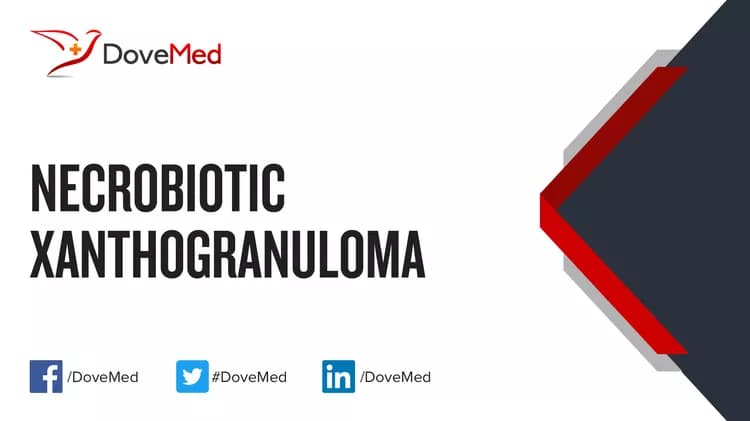What are the other Names for this Condition? (Also known as/Synonyms)
- NXG (Necrobiotic Xanthogranuloma)
What is Necrobiotic Xanthogranuloma? (Definition/Background Information)
- Necrobiotic Xanthogranuloma (NXG) is an uncommon and acquired form of non-Langerhans cell histiocytosis that generally affects older adults. NXG is a multisystem disorder, meaning that there may be the involvement of several organ systems, notably involving the eyes, liver, and spleen, apart from the skin
- Xanthogranuloma is a tumor-like formation comprising of histiocytes (immune cells in blood). In Necrobiotic Xanthogranuloma, there is a breakdown of collagen fibers (type of connective tissue fibers) causing a buildup of these fibers in the tissues, which can be seen when a pathologist examines a tissue under the microscope
- In some cases, Necrobiotic Xanthogranuloma is associated with monoclonal gammopathy, blood cancer, or lymphoproliferative disorder. Even though it is challenging to treat NXG, the condition may be adequately managed via chemotherapy and/or radiation therapy. The prognosis is generally good with early diagnosis, appropriate treatment, and in the absence of significant complications
Who gets Necrobiotic Xanthogranuloma? (Age and Sex Distribution)
- Necrobiotic Xanthogranuloma is a rare disorder that is normally noted in older adults
- Both males and females may be affected
- Worldwide, individuals of all racial and ethnic groups may be affected
What are the Risk Factors for Necrobiotic Xanthogranuloma? (Predisposing Factors)
The risk factors identified for Necrobiotic Xanthogranuloma may include preexisting conditions such as:
- Paraproteinemia - it is observed in nearly 80% of the affected individuals
- Blood cancer
- Lymphoproliferative disorders - disorders in which an excess production of lymphocytes is noted such as lymphomas and leukemias
In some cases, these disorders may arise several years after Necrobiotic Xanthogranuloma is diagnosed.
It is important to note that having a risk factor does not mean that one will get the condition. A risk factor increases one’s chances of getting a condition compared to an individual without the risk factors. Some risk factors are more important than others.
Also, not having a risk factor does not mean that an individual will not get the condition. It is always important to discuss the effect of risk factors with your healthcare provider.
What are the Causes of Necrobiotic Xanthogranuloma? (Etiology)
- Presently, the exact cause of formation of Necrobiotic Xanthogranuloma (NXG) is not well-understood. It is a chronic and acquired form of non-Langerhans cell histiocytosis
- However, a strong association is reported between some pre-existing conditions and the development of NXG, including:
- Presence of abnormal proteins in conditions such as monoclonal gammopathy
- Blood cancer
- Lymphoproliferative disorders such as lymphocytic leukemia
Non-Langerhans cell histiocytosis indicates histiocytosis (abnormal increase in histiocytes i.e., immune cells in blood) characterized by the lack of Langerhans cells (types of immune cells originating in the bone marrow). Besides NXG, there are a variety of disorders that are grouped as non-Langerhans cell histiocytosis.
What are the Signs and Symptoms of Necrobiotic Xanthogranuloma?
The signs and symptoms of Necrobiotic Xanthogranuloma may vary among affected individuals in type and severity. In some cases, the condition may be asymptomatic.
The signs and symptoms may include:
- Presence of a single or multiple yellow, thickened, or raised lesions (plaque)
- These are often symmetrically placed with a tendency to ulcerate and atrophy
- The lesions are usually noted bilaterally around the eyelids and can result in the following issues. Eye signs and symptoms are noted in nearly 50% of the cases:
- Burning or itching eyes
- Blurred and/or double vision
- Bulging of the eyeball
- Drooping of the eyelid
- Restricted eye movement
- Lesions may occur on the skin of the trunk, legs, face, and arms
- Some are present on the oral mucosal surfaces (in the mouth)
- Even the heart, liver, spleen, intestines, kidneys, and ovarian tissue have been involved
- Based on the underlying condition type, other presentations may include vomiting, nosebleeds, fatigue, and back pain
In some individuals, Raynaud phenomenon is noted. Raynaud phenomenon is a condition wherein there is abnormal constriction of the arteries causing episodes of decreased blood flow to the fingers and hands, and toes.
How is Necrobiotic Xanthogranuloma Diagnosed?
Necrobiotic Xanthogranuloma is diagnosed on the basis of the following information:
- Complete physical examination with comprehensive evaluation of medical history
- Assessment of the signs and symptoms
- Blood tests and other investigative studies to diagnose an underlying condition or malignancy, if necessary
- Dermoscopy: It is a diagnostic tool where a dermatologist examines the skin using a special magnified lens
- Wood’s lamp examination: In this procedure, the healthcare provider examines the skin using ultraviolet light. It is performed to examine the change in skin pigmentation
- Skin biopsy: A skin tissue biopsy is performed and sent to a laboratory for a pathological examination, who examines the biopsy under a microscope. After putting together clinical findings, special studies on tissues (if needed) and with microscope findings, the pathologist arrives at a definitive diagnosis. A skin biopsy is often needed to establish a diagnosis
- Bone marrow aspiration and biopsy, if required
A differential diagnosis may be necessary to eliminate other conditions that present similar signs and symptoms. This may include:
- Granuloma annulare
- Necrobiosis lipoidica
- Xanthogranuloma
Many clinical conditions may have similar signs and symptoms. Your healthcare provider may perform additional tests to rule out other clinical conditions to arrive at a definitive diagnosis.
What are the possible Complications of Necrobiotic Xanthogranuloma?
The complications of Necrobiotic Xanthogranuloma may include:
- Cosmetic concerns
- Emotional stress
- Angioedema from complement pathway abnormalities
- Ulceration of skin lesions causing secondary infections
- Development of giant cell myocardial disease if lesions involve the heart
- Organ involvement causing organ failure
- Recurrence of lesions after treatment
- Complications that may be associated with the pre-existing disorder such as blood cancer
Complications may occur with or without treatment, and in some cases, due to treatment also.
How is Necrobiotic Xanthogranuloma Treated?
The treatment is usually given to manage the signs and symptoms and any complication that develops. It is also important to treat any associated or underlying condition that is causing NXG.
- Chemotherapy with alkylating agents is normally the treatment of choice, along-with radiation therapy, as necessary
- Other treatment measures include:
- Oral and intralesional corticosteroids
- Intravenous immunoglobulin therapy
- Interferon alpha
- Plasmapheresis
- Surgical excision
Regular medical screening at periodic intervals with tests and physical examinations are recommended.
How can Necrobiotic Xanthogranuloma be Prevented?
Presently, there are no guidelines or methods available to prevent Necrobiotic Xanthogranuloma.
- Seeking medical attention as soon as symptoms become apparent may help prevent complications from developing
- Undertaking treatment of any malignancy, such as blood cancer or lymphoproliferative disorder, is important
What is the Prognosis of Necrobiotic Xanthogranuloma? (Outcomes/Resolutions)
The prognosis of Necrobiotic Xanthogranuloma is dependent upon the severity of the signs and symptoms and associated complications, if any. Even though there is no cure for the condition, NXG can be treated successfully, and the outcomes are generally good.
- Affected individuals require life-long monitoring to avoid systemic disease and prevent or treat recurrences
- In addition, a pre-existing condition, such as blood cancer or lymphoproliferative disorder, may adversely affect the outcomes. Also, since in some individuals, the development of such malignancies succeed the onset of NXG, long-term vigilance is highly recommended
Additional and Relevant Useful Information for Necrobiotic Xanthogranuloma:
The following DoveMed website link is a useful resource for additional information:
Related Articles
Test Your Knowledge
Asked by users
Related Centers
Related Specialties
Related Physicians
Related Procedures
Related Resources
Join DoveHubs
and connect with fellow professionals



0 Comments
Please log in to post a comment.